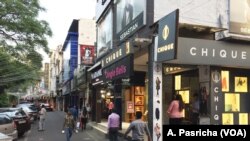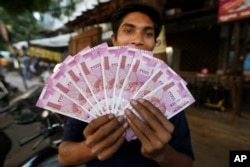After several years of struggling to make a living doing odd jobs in and around his village, 26-year-old Pushkar Singh came to New Delhi from the northern Uttarakhand state three months ago to hunt for a job.
The high school dropout is willing to do anything — cook, work as a security guard, a peon in an office. But not only has he failed to secure a job, he has not even got an interview so far.
“It’s a huge worry, not having work,” said a despondent Singh as he wondered how long he can continue staying with his relatives.
The hopes of young people like Singh had been fueled by Prime Minister Narendra Modi’s promise of creating millions of jobs for the country’s huge young population when he took power in 2014. Optimism rose after India won the tag of the world’s fastest growing economy.
But the Indian economy has hit a sharp slowdown, leaving tens of thousands of people struggling to find work in mega cities like New Delhi, which are magnets for migrant labor.
The economy clocked a growth rate of 5.7 percent in the April to June quarter, its most sluggish pace in three years.
The bleak number has set alarm bells ringing and raised fears that India could struggle to return to a high growth path.
“It is a cause for concern, the economy has slowed down much more than most had expected,” said D.K. Joshi, Chief Economist at rating agency Crisil in Mumbai.
Reasons for the slowdown
The slowdown has prompted critics to accuse Modi’s government of economic mismanagement.
Most attention has turned to two major measures that have disrupted the economy in the last year. Critics have slammed the government for imposing a currency change last November to flush out illegal cash, saying it slowed down businesses amid massive currency shortages and gave an unnecessary shock to a cash dependent economy.
In July, India implemented a long overdue and widely welcomed tax reform — a goods and services tax (GST) meant to clean up a complex tax regime and make it easier to do business.
But many worry that faulty implementation and multiple tax rates have created confusion for businesses struggling with the new system.
Economists point out that the currency change and GST, coming within months of each other, have made the slowdown sharper and deeper for virtually all sectors of the economy, which had already started losing pace last year.
The impact is evident in the markets of the Indian capital, which are usually the most crowded at this time of the year. It is India’s main festive season, when consumer spending hits a high. But shop owners are disappointed because customers are not opening their wallets easily.
A usually buzzing upmarket area in New Delhi wears a deserted look. Manu Talwar, the owner of a shop selling high-end mobile phones, has been struggling to make a sale in a country counted as the world’s fastest growing smart phone market, where a new device is coveted by an aspirational generation.
“You can see the market, it does not look like Diwali, the market is so down. Mobiles, accessories, people were crazy about it. As of now, iPhone 8 has launched, but there is no market,” said Talwar.
The government says it is looking for ways to rev up the economy — according to reports, it is considering spending billions of dollars to give investment a push.
Prime Minister Modi, seen as a business-friendly, reformist leader, recently announced the formation of a five-member panel to advise him on economic issues.
At the heart of the challenge is the need for jobs in a country where about 10 million enter the workforce every year. Modi had hoped to give manufacturing a push to create jobs for low-skill labor, but a flagship “Make in India’ program he launched to woo foreign investors has yet to show significant results. And a slowing economy means that jobs are even being lost in several sectors.
“To think of an overall manufacturing push of the kind China gave, or many East Asian economies that we observed in those economies, that does not seem to be a reality in India. There is a lot of ground to cover to reach that level,” said economist Joshi.
Officials are striking an optimistic note, calling the slowdown transitory, but economists warn recovery will be gradual.
That means Pushkar Singh’s hunt for a job and shop owner Manu Talwar’s hopes of the market picking up may not happen anytime soon.











